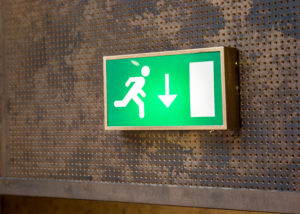Emergency lighting is a requirement under the Regulatory Reform (Fire Safety) Order 2005 (RRFSO) in all non-domestic buildings and in communal areas of HMO (houses of multiple occupancy). The lighting’s purpose is to illuminate emergency exits and escape paths in the case of a mains power failure.

As set out in British Standard 5266, all emergency lighting serviced by Churches Fire & Security technicians meets the required standards.
This will include, but not be limited to:
- Checking the condition and expiry of batteries
- Testing switches and bulbs
- Examining the fittings
- Confirming correct locations of emergency lighting
- Checking the circuitry of the system
IMPORTANCE OF EMERGENCY LIGHTING
Being a requirement of the RRFSO, factories, hotels, shops, sports stadiums and offices all have the responsibility of making sure their fire exits are adequately covered by emergency lighting. Landlords and property managers of houses of multiple occupancy also have this obligation.
A fire or power cut could cause a mains power failure, plunging buildings into total darkness, posing a risk to those in the area.
When in position to illuminate exits, emergency lighting helps those on site to safely egress. Standby lighting can activate when the power is cut and allow for some normal activity to continue. To ensure an exit is appropriately lit, escape route lighting is used. This is perhaps the most recognisable piece of emergency lighting equipment due to its familiar ‘running man’ image and bold green colour.
HOW DOES EMERGENCY LIGHTING WORK?
Emergency lighting systems are usually wired into a property’s mains power supply to ensure the continuous charging of the internal lighting batteries. The constant charge acts as a back-up power source. When a power failure is detected, the lights automatically switch to the back-up and illuminate. These batteries power the light for a minimum of 3 hours, with reduced light output to conserve power.
EMERGENCY LIGHTING MAINTENANCE
Customers using emergency lighting from Churches Fire & Security are encouraged to perform monthly tests to ensure correct functionality. We are happy to provide guidance on how to execute these tests, with the understanding that more in-depth safety inspections must be carried out annually by the qualified technician.
In this short video guide, we have demonstrated how to complete this simple test:
UNIFIED FIRE SAFETY SERVICES
In order to provide a consistent servicing schedule and save our customers time, we are often requested to be the sole source of both fire safety and security provisions.
As many of our technicians are multi-skilled in fire and security products, one service visit could see multiple pieces of equipment maintained. Using fully stocked company vans and with access to storage units containing spare parts, we are regularly able to offer our customers a first time fix.
Churches Fire & Security has provided fire safety services to customers across the United Kingdom for over three decades, reinforcing our position as one of the most trusted suppliers in the industry.
Talk to Churches Fire & Security about combining your fire safety and security services and maintenance with one trusted, industry-leading provider.
Contact us





